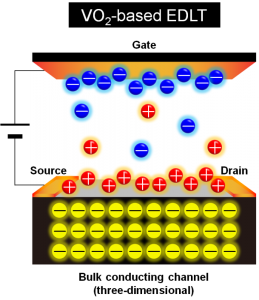Switching the state of matter New transistor harnessing correlated electrons enables electrical switching of the state of matter


A schematic device structure of a VO2-based electric-double-layer transistor enabling bulk three-dimensional phase transition. © Masaki Nakano
Researchers at the University of Tokyo’s Department of Applied Physics and RIKEN have developed a new field-effect transistor using a strongly correlated vanadium oxide and an electric double-layer structure that has the potential to transform low-power electronics. Applying a voltage comparable to that of an ordinary battery to the surface of the oxide results in a transformation of the charge state of the entire material and alteration of its crystal structure. Professors Yoshihiro Iwasa, Masashi Kawasaki, and Yoshinori Tokura of the Department of Applied Physics in the University of Tokyo worked in collaboration with Masaki Nakano and scientists at RIKEN. This result opens the door to next-generation ultra-low power consumption switching devices, as well as to new applications such as a non-volatile memory and optical switches.
Press release (RIKEN)
Paper
M. Nakano, K. Shibuya, T. Hatano, S. Ono, M. Kawasaki, Y. Iwasa, and Y. Tokura,
“Collective bulk carrier delocalization driven by electrostatic surface charge accumulation” ,
Nature 487, 459 (2012). doi: 10.1038/nature11296.
Article link






